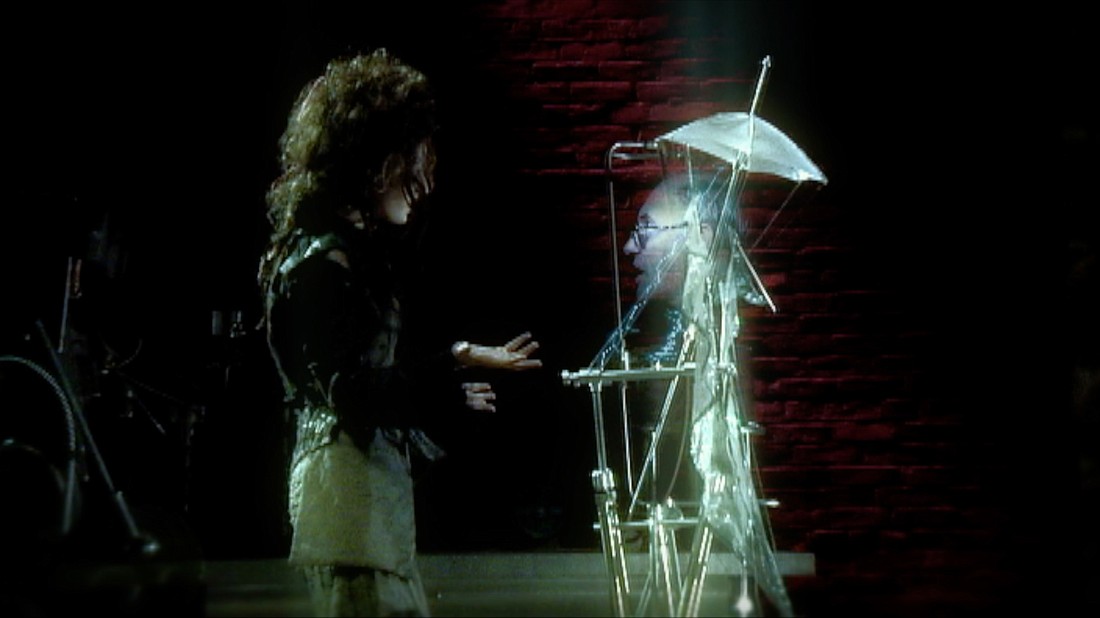- April 24, 2024
-
-
Loading

Loading

Can a movie be performed? Ordinarily, the answer is no. The film is the film — and it is what it is. It comes out of the projector and hits the screen at 24 frames per second. What you see is what you get. Ordinarily.
Toni Dove’s “Spectropia” is a different kettle of interactive fish. The movie isn’t shown so much as staged. That’s exactly what happened on March 9 at the Ringling Museum courtyard. The live performance unfolded as part of the “Toni Dove: Embodied Machines” exhibition.
It was a crisp, late winter evening. The weather cooperated. Except for one quickly fixed glitch, the technology did as well.
Dove and R. Luke DuBois (her software engineer and collaborator) had rigged up the courtyard with three screens behind a stage. They perched at one end of the stage behind a tangle of equipment. Their high-tech gear reminded me of a drum kit, but it was actually three computer monitors and motion-sensing technology. The motion it sensed was theirs.
When the spectacle began, DuBois and Dove waved their hands in the air in a gestural frenzy like a nervous game of charades combined with interpretive dance. Their motions made no sense to me, but perfect sense to the digital floor director. (Which could see in infrared, allowing Dove and DuBois to stay in darkness.) Once the movie started, the hardware translated their fluttering hand motions into scene jumps and jittery pauses, stops and starts. Think VJs instead of DJs. Instead of scratching records, they mixed and sampled digital imagery.
The movie itself played out in a fragmented spectacle on three screens. The main action was usually in the center, flanked by peripheral viewpoints (and live-cam glimpses of the VJs) on the sides.
The show kicked off with a Max Headroom-y introduction by two digital avatars, Sally Rand (Helen Pickett) and William (Richard Bekins). Dove and DuBois typed in witty text and Sally and Max spoke it, basically. The text-to-speech system also drew from a library of lip movements, making the digital puppets appear to speak. The verisimilitude approaches a bad dub of “Speed Racer,” but I figure that was intentional. This is cyberpunk. It’s not supposed to be slick.
The cheeky introduction finally yielded to the actual film.
With all its starts, stops, and interactive gallimaufry, the movie itself is a straight-up ghost story. It’s set in a future that’s erased its past and made relentless consumption the law. Spectropia (Angela Darmody, of HBO’s “Boardwalk Empire”) is a typically atypical cyberpunk rebel. She cleverly bends the rules of finance and physics. Her latest quest? She travels back in time to find her time-traveling father. No crackling spheres of energy are required. Spectropia’s mode of temporal transport is, appropriately, spectral. She’s a ghost from the future possessing a living woman in the past. Her host Verna (Carolyn McCormick), is a female detective working in gritty New York City in the early, ugly days of the Great Depression. Two women in the same body fight for control and wind up in an amusing romantic triangle with a guy they both don’t really like. Aside from this distraction, Spectropia follows a paper trail of deception and dispossession leading to her missing father and the initial “Chinatown” plot that set the stage for Spectropia’s grim, sold-out future. Pursuing that trail, she falls down a film noir rabbit hole. As to what she finds there …
I won’t spoil the revelation, in case you plan to watch this movie in your future. (It’s available on YouTube, sans interactive shenanigans.)
Dove’s future noir fable has some of the grit of early William Gibson and, yes, the dystopian TV party of “Max Headroom.” Her movie comes together with a pretty cool music score by Elliott Sharp, who sends you home with the appropriately haunting “This Time, That Place,” sung by Deborah Harry over the end credits.
The film could stand on its own without live VJs. But the interactive experience took it to the next level. They say a movie that’s been shot is “in the can.” But this movie was un-canned. And the filmmaker behind it wasn’t an abstraction. You could see Toni Dove on stage. You could watch as she and DuBois put the movie together right before your eyes.
Hard visual evidence …
That the machinery of this movie is ghost-free. There were people behind it all along. Can a movie be performed?
Dove and DuBois proved the answer was “yes.”
While “Spectropia” is in the past, two live performances of Dove’s “Lucid Possession” are still in the future at The Ringling. If you’re curious, put it on your calendar … or the dials of your time machine.
The choice is yours.